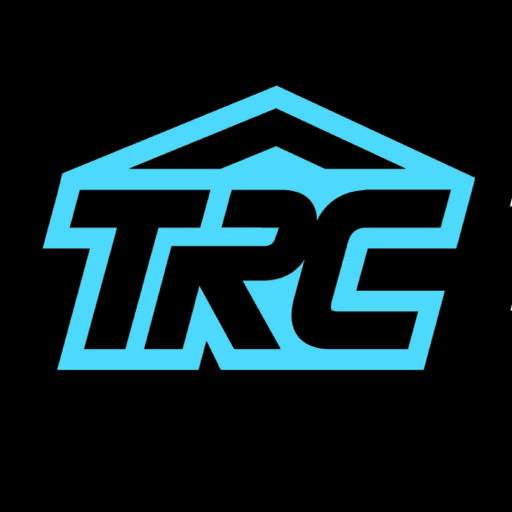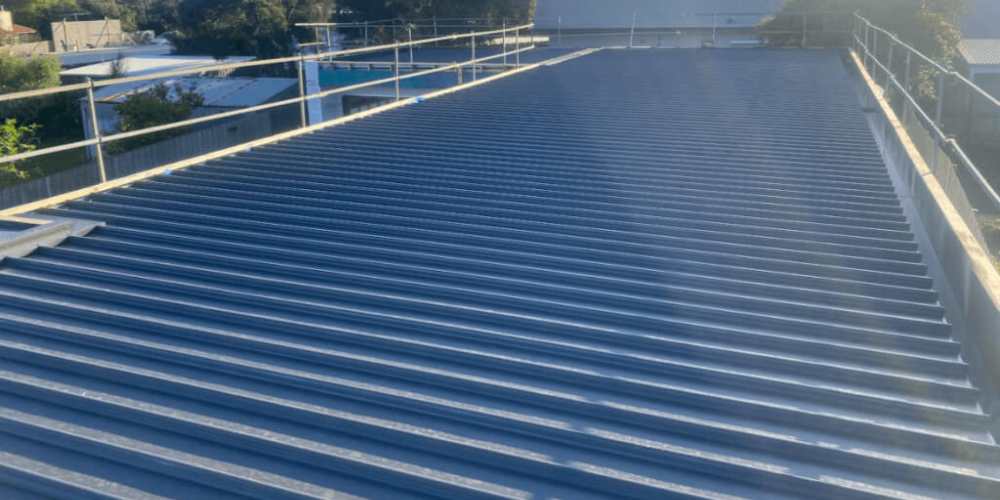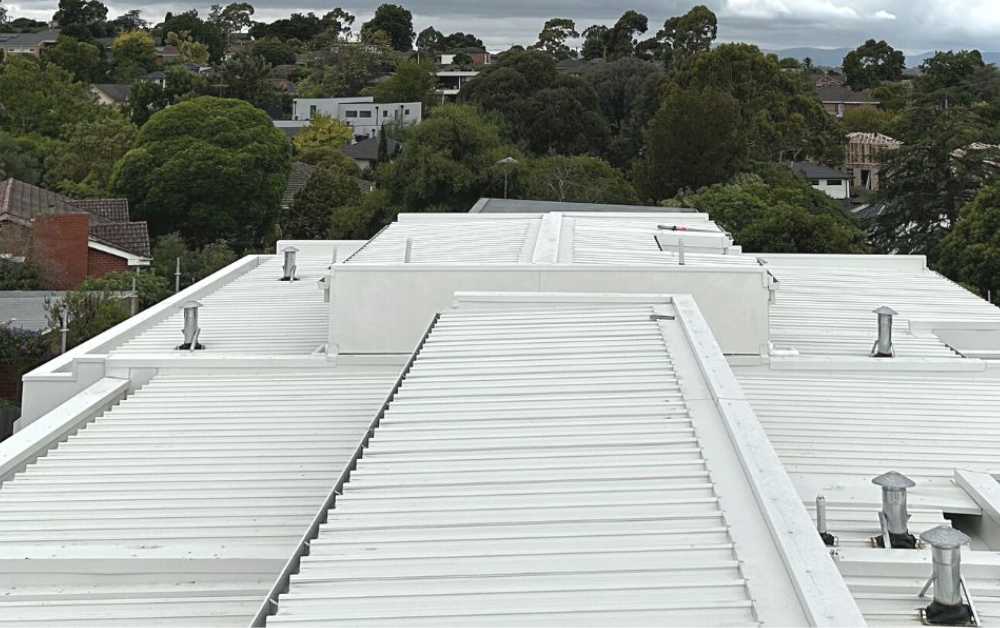Upgrading to Colorbond Roofing: What to expect
Suppose you want to give your home a new and modern design while increasing its durability and energy efficiency. In that case, Colorbond Roofing may be your new best friend. Who wouldn’t want a roof that makes your house seem like a million bucks and stands up to everything Mother Nature throws?
Imagine this: you’re sitting on your porch, appreciating the view, and a thought pops into your head, “Time for an upgrade.” We’ve all been there. You want your home to have that wow factor, that eye-catching attractiveness that makes your neighbors look twice. However, looks are not everything. You want something that can withstand the elements (rain, wind, and sun) without breaking a sweat.
That’s where Colorbond Roofing swoops in to save the day.
Alright, here’s the scoop: we’re here to be your Colorbond roofing gurus. In this blog series, we’ll spill the beans on everything you should expect when upgrading to a Colorbond roof. From selecting the perfect shade to make your house pop to nailing that sleek installation, we’ve got you covered.

Lance Mathews
In This Article
What is a Colorbond Roofing?
We define Colorbond Roofs as a roofing brand manufactured by BlueScope, a leading steel company. It is a brand name for pre-painted steel roofing and cladding components used in residential, commercial, and industrial construction. Colorbond roofing is a well-known material for its durability, adaptability, and visual appeal.
Colorbond roofing is often used for residential residences, commercial buildings, warehouses, sheds, and other structures that require a blend of aesthetics, durability, and functionality. Its appeal stems from its capacity to improve a building’s look while offering solid protection and energy efficiency. Colorbond roofing is an option worth considering whether you want a modern style, weather resilience, or a lasting roofing solution.
Why Should You Switch to a Colorbond Roof?
Switching to a Colorbond roof has several appealing advantages that may significantly improve the functionality and visual appeal of your home or building. Here are some good reasons why you should consider switching:
Durability
Colorbond is not your typical roofing material. Its sturdy design and high-quality steel composition make it extremely durable, weathering even the harshest environments. Colorbond roofing stands firm in severe rain, snow, hail, or high winds, retaining structural integrity and safeguarding your property for years. Its corrosion resistance assures that metal will not deteriorate over time, especially in coastal or humid conditions.
Longevity
Choosing Colorbond means investing in a roofing solution that will last for a long time. Unlike other roofing materials that disintegrate or wear out rapidly, Colorbond roofing lasts long. This durability reduces maintenance headaches and a lower need for costly replacements, making it a cost-effective and sensible long-term investment.
Weather Protection
Colorbond roofing is designed to withstand a variety of weather situations. It protects your home from rain and wind and withstands high sunshine and UV rays without fading or deteriorating. This weather resilience guarantees that your roof continues to protect the interior of your home, keeping you and your family comfortable.
Energy Conservation
Aside from its physical robustness, Colorbond roofing has an energy-saving advantage. Its reflecting characteristics deflect a large percentage of the sun’s heat, preventing excessive heat absorption into your home. This implies that during the hot summers, your interior will stay cooler, putting less pressure on your air conditioning system and resulting in cheaper energy expenses. It’s a smart choice for both your comfort and your wallet.
Aesthetic Versatility
Colorbond Roofing recognizes how important your home’s beauty is. By selecting from various colors and finishes, you may tailor your roof to meet your architectural style and personal taste. Colorbond covers whether you want a strong, trendy style or a more subdued traditional mood. This aesthetic adaptability empowers you to improve curb appeal and make your property stand out.
Easy to Maintain
One of the advantages of Colorbond roofing is that it requires less maintenance. Unlike other roofing materials that require frequent cleaning, painting, or repairs, Colorbond roofing requires periodic cleaning to maintain its appearance. This means spending less time and effort on roof maintenance and more time enjoying the advantages of a beautiful, long-lasting roof.
Considerations for the Environment
If you care about the environment, Colorbond Roofing is for you. Colorbond products are made from recyclable steel, making them a sustainable solution that minimizes the demand for new raw materials. By using Colorbond, you can help the environment while also enjoying its various functional and aesthetic benefits.

How To Plan Your Colorbond Roof Upgrade?
Colorbond roof upgrades need meticulous planning and preparation to guarantee a seamless and effective transition. Here’s a step-by-step guide to help you efficiently plan your Colorbond roof upgrade:
Research and Gather Information
Begin by studying Colorbond roofing and its advantages. Investigate the many colors, profiles, and finishes available. To make an educated selection, learn about the technical characteristics and benefits of Colorbond roofing.
Make a Budget
Determine how much money you will put into the Colorbond roof improvement. Consider the cost of materials, labor, and other costs, such as insulation or gutter replacement.
Choose a Color and Style
Select a Colorbond color that enhances the outside of your house and suits your aesthetic choices. Consider your home’s architectural style and how the new roof will fit the overall design.
Consult Professionals
Consult with roofing contractors or Colorbond installation pros. Request various bids and set up appointments to talk about your project, get professional advice, and grasp the extent of the task.
Inspect Current Roofing
Have your old roof evaluated to determine its condition and identify any potential concerns that must be addressed before installing Colorbond. This might include repairs, removing outdated roofing materials, or structural changes.
Obtain Necessary Permits
Check with your local authorities or building departments to see whether you need permits for the roof improvement. Before you begin work, ensure you have obtained all essential approvals.
Plan the Timing
Coordinate the upgrade’s timing with your chosen contractor. Consider weather conditions, material availability, and your timetable to guarantee a simple and quick installation procedure.
Prepare Your Home
Clear the space surrounding your property to provide the roofing crew with free access. Remove anything that might obstruct the installation process. Keep dust and dirt away from expensive belongings in your attic or upper levels.
Examine the Contract and Terms
Examine the contract with your selected contractor thoroughly before work begins. Ensure all aspects are fully specified and agreed upon, including supplies, labor, timeframes, and expenses.
Schedule the Upgrade
Set a date for the Colorbond roof upgrade to begin. Confirm the timeline with your contractor and make any required accommodations for the job.
During Installation
Stay informed and involved during the installation process. Communicate with your contractor, address any issues or queries, and check that the job is moving as expected.
Final Check and Approval
Following the completion of the installation, do a final inspection with the contractor to confirm that the Colorbond roof fulfills your expectations and complies with quality requirements.
Keep Documentation
Keep all Colorbond roof upgrade documents for future reference, including warranties, contracts, and invoices.
Colorbond Roofing Installation Process
Colorbond roofing installation entails numerous procedures to guarantee a stable, weather-resistant, and visually beautiful roofing solution. The following is an overview of the Colorbond roofing installation process:
Preparation and Safety Precautions
The installation staff establishes the essential equipment and safety procedures before work begins. Scaffolding is built around the work area to provide a safe platform for the roofing contractors. Safety barriers and signage are installed to protect workers and property occupants, creating a safe and regulated installation environment.
Inspection and Repair of Structures
The underlying structure of the roof is meticulously investigated to determine its integrity. Rot, deterioration, and structural problems are all diagnosed and corrected. Repairs may include repairing broken rafters or strengthening the framework to ensure that the weight of the Colorbond roofing material is correctly supported.
Underlayment and Insulation
Insulation is installed between the roof’s supporting parts to improve energy efficiency and avoid moisture concerns. This aids in the regulation of indoor temperatures and the reduction of energy use. A roofing underlayment, also known as sarking, is put in to protect against potential water penetration, condensation, and dust.
Flashing, Ridge Capping, and Gutters
Flashings are carefully placed around roof penetrations such as chimneys, vents, and skylights. These metal components form a watertight barrier that prevents leaks and directs water away from susceptible places. Ridge capping is installed at the top of the roof to hide the gaps between Colorbond sheets, adding weather protection and a polished appearance. In addition, gutters and downspouts are built to effectively control rainfall runoff, keeping water from accumulating on the roof and diverting it away from the property’s foundation.
Final Inspection and Documentation
After the installation, a full final inspection is performed to ensure that all parts of the Colorbond roofing system are in place and operating properly. The installation crew inspects the sheeting for appropriate alignment, secure attachment, and integrity of the flashings, ridge capping, and gutter systems. Any debris or leftover materials are removed, leaving the space clean and ready to use. The client is then given detailed paperwork, including warranties, outlining the work and materials used in the Colorbond roofing installation.
Potential Challenges and How to Overcome Them
While Colorbond roofing has various advantages, like every construction job, it may provide its own set of obstacles. Here are some potential obstacles and solutions to overcome throughout the Colorbond roofing installation process:
Structural Issues and Repairs
Challenge: During the inspection, underlying structural issues may be discovered, necessitating further repairs before installation can begin.
Solution: Collaborate closely with professional contractors who can quickly repair structural concerns and guarantee the roof’s framework is solid before installing Colorbond roofing.
Weather Delays
Challenge: Unpredictable weather might cause delays in the installation procedure, potentially altering the timeframe.
Solution: timetable the installation during a good weather window and contact the contractor to change the timetable as needed. Weather-related delays can be mitigated by having a flexible schedule.
Budget Considerations
Challenge: Unexpected charges or changes in project scope might put a strain on your budget.
Solution: Include some wiggle room in your budget to adjust for unanticipated charges. Regular communication with the contractor and a clear knowledge of any additional charges can assist you in properly managing your budget.
Permit and Approval Delays
Challenge: The difficulty is that obtaining the appropriate permissions and approvals might often take longer than expected.
Solution: Start the permission application procedure before the installation start date. Work closely with your contractor to ensure all necessary documentation is completed correctly and on schedule.
Coordination with Other Trades
Challenge: Coordination of other renovations or trades with the Colorbond installation might be difficult if your project includes other renovations or trades.
Solution: Open communication amongst all parties concerned is essential. Ensure all contractors know the project timeframe and collaborate to reduce disagreements and interruptions.
Property Access and Logistics
Challenge: The delivery and installation of materials might be hampered by limited access to the property or complex logistics.
Solution: Plan ahead of time for material deliveries and make sure contractors and equipment have enough access. Remove any impediments to the installation procedure.
Unforeseen Issues During Installation
Challenge: Unexpected difficulties may develop during installation, necessitating rapid judgments and modifications.
Solution: Hire experienced contractors that are prepared to deal with unanticipated situations. Regular site inspections and open communication can aid in identifying and resolving concerns.
Disruption to Daily Life
Challenge: The installation procedure may interfere with your everyday routines and activities.
Solution: Talk with the contractor about the project timeframe and prepare appropriately. Consider temporary accommodations or changes to your schedule throughout the installation time if necessary.
Color and Style Decisions
Challenge: Selecting the proper color and design for your Colorbond roofing may be difficult.
Solution: Consult with specialists or experts who can give color samples and recommendations based on the design and surroundings of your property. Take your time to choose a decision that fits your needs.
Maintaining Your New Colorbond Roof
Maintaining your new Colorbond roof over time is critical to ensure its longevity, aesthetics, and performance. While Colorbond roofing is intended to be low-maintenance, maintaining it regularly may help keep its quality and safeguard your investment. Here’s how to properly maintain your Colorbond roof:
Regular Inspections
Visually examine your Colorbond roof regularly. Examine the item for indications of wear, damage, or degradation. Look for missing or loose screws and locations where the paint may be peeling or flaking. Early discovery of problems allows you to treat them before they worsen, preserving the structural integrity of your roof.
Remove Debris
Clear the roof of debris such as leaves, branches, mud, and pine needles. Debris can trap moisture, allowing rusting or the growth of moss and algae to occur. Clean the roof regularly to minimize debris buildup, which can lead to problems down the road.
Gutter Cleaning
Gutter and downpipe operation is critical for successful water drainage. Clear leaves, twigs, and debris from gutters and downspouts to avoid water backup, which can cause leaks, water damage, and structural issues. Cleaning and maintaining gutters regularly ensures that rainfall is adequately directed away from your roof and foundation.
Flashings and Seals
Flashings are essential components that keep water out of susceptible parts of your roof, such as around chimneys, vents, and skylights. Inspect these flashings regularly for evidence of corrosion, rust, or wear. Check that all seals and caulking are intact and not degrading since defective seals can lead to water leaks and consequent interior damage.
Professional Maintenance
While you may do routine checks, professional maintenance should be scheduled every few years. Experienced roofing specialists may conduct extensive examinations, discover any concerns that aren’t immediately obvious, and provide targeted maintenance or repairs. Regular expert maintenance catches and addresses issues early, extending the life and performance of your Colorbond roof.
Frequently Asked Questions
Yes, Colorbond roofing may be placed over existing roofs. However, before installation, the quality of the existing roof structure and any necessary repairs should be evaluated.
Colorbond roofing is built to endure harsh weather conditions such as rain, wind, and direct sunshine. Because of its corrosion resistance, it is also suited for coastal environments.
Consider the architectural style of your property, its surroundings, and your tastes. Many Colorbond vendors include color samples and visualizer tools to assist you in making an educated selection.
Colorbond roofing requires minimal maintenance. Regular inspections, clearing dirt, and swiftly resolving minor concerns can all assist in extending its lifetime and attractiveness.
Conclusion
Choosing Colorbond roofing for your house or business may provide several benefits beyond improving its aesthetic appeal. Colorbond roofing is a wise and practical investment because of its longevity, weather resistance, energy efficiency, and design diversity. As you engage on this upgrading path, it is critical that you handle it wisely and with care. Each stage, from choosing the proper color and design to working with qualified specialists for installation, adds to the project’s overall success.
A well-maintained Colorbond roof adds value and visual appeal to your house. It gives you peace of mind since you know your home is well-protected by a roofing solution that combines durability, style, and sustainability. So, whether you want to modernize the appearance of your home, enhance energy efficiency, or strengthen its resistance, Colorbond roofing is a dependable option that genuinely delivers on its promises.

